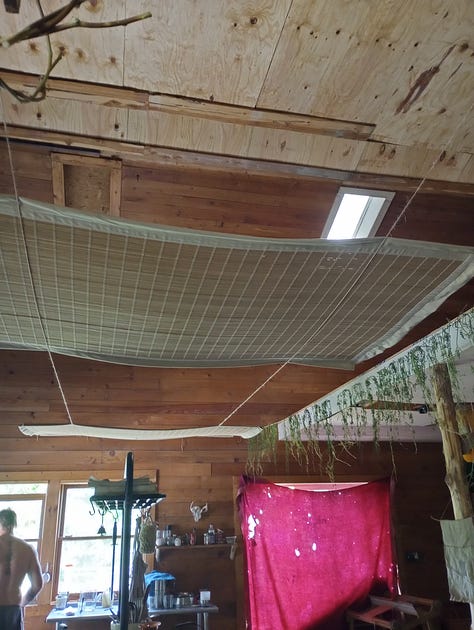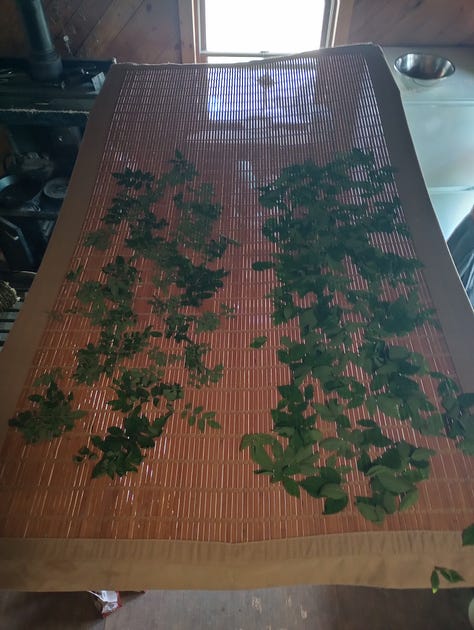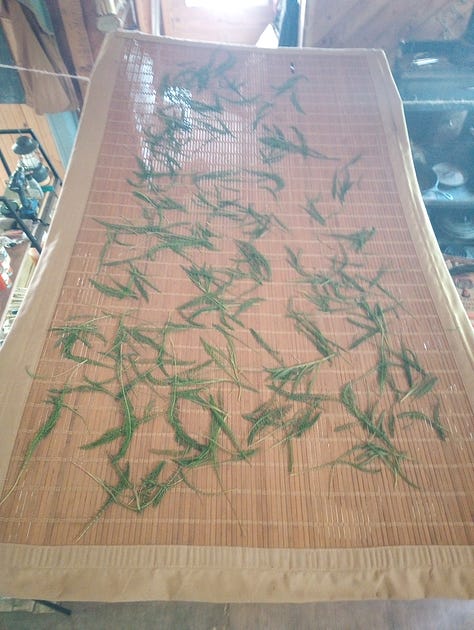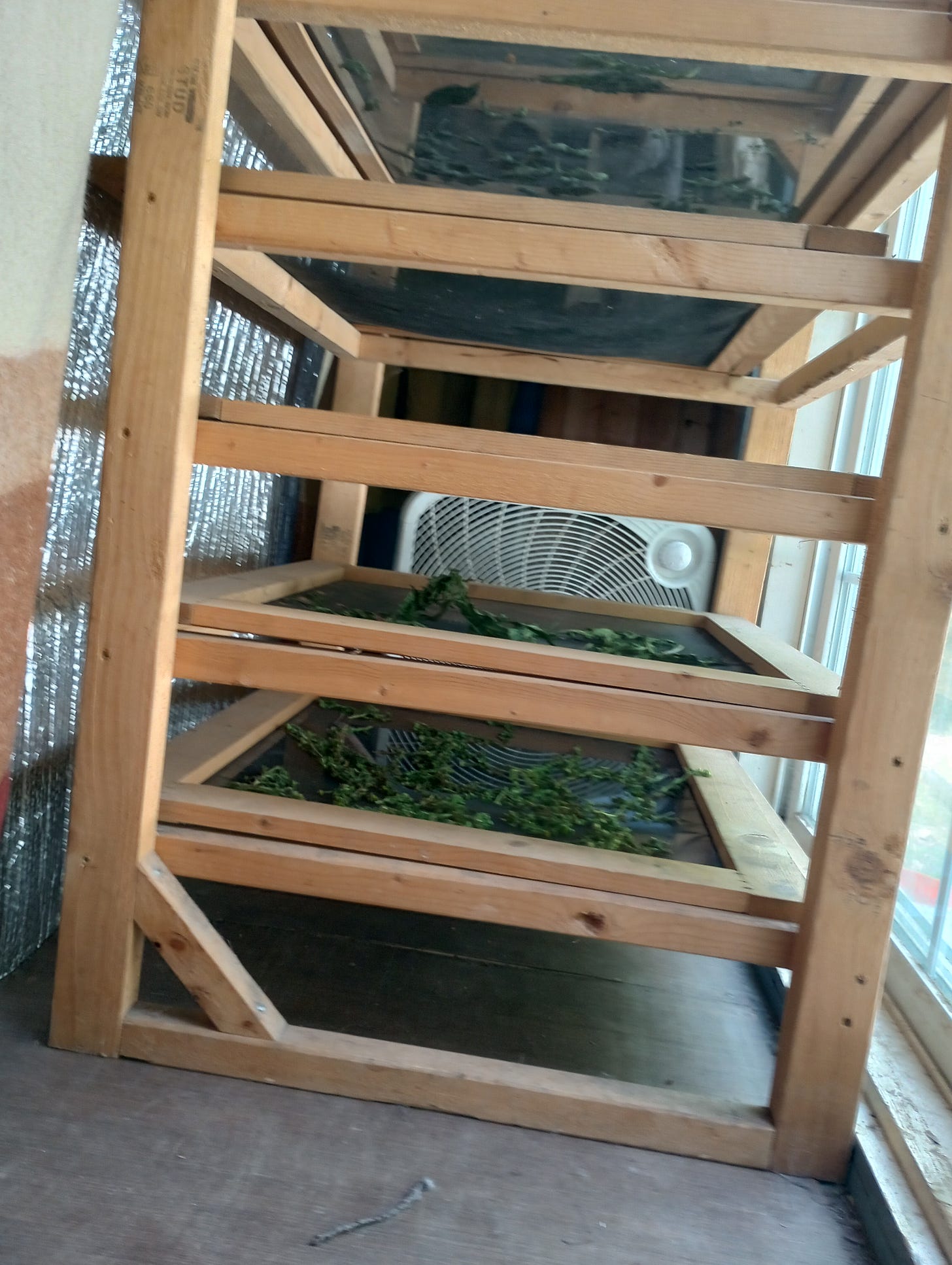Harvesting and Processing Herbs
I realized that I am starting to give “Meet Your Plants” posts but haven’t talked about the harvesting and processing guidelines I follow.
First - I don’t harvest wild plants from the United Plant Savers at risk list. We are a UPS botanical sanctuary and are working on cultivating some of the plants on this list - such as Black cohosh and Solomon’s seal. Every year I try to add one or two more. Plants like Butterfly weed/Pleurisy root (Asclepsia tuberosa) and Arnica (Arnica spp), I grow in the gardens or meadow area (I grow meadow Arnica, not mountain Arnica)
Second - I only harvest when I “feel” I have permission for. Over the years I have asked the plant directly but I have gotten to the point when I communicate with plants without having to a say a word. Even with a plant as abundant of Yarrow, I have gotten a “no” and a “no more”. If you aren’t familiar with this practice, I recommend starting now. At the very least, it increases your intention and fosters a right relationship with you and the plants.
Third - I don’t overharvest, even if its in abundance. I have generally figured out how much I need for the apothecary (for home and clients) for the year and don’t harvest over that. If I end up having more by the next harvest, I try to give it away. What I can’t give away, I give to the animals, what the animals don’t want, goes in the compost for the garden. Then I learn, maybe we don’t use that much herb…and harvest less. Once you really know the plants, even if you realize you had more colds that Winter, you will be able to use whatever you have on hand and use it efficiently.
Fourth- I harvest mainly on our private land or public land. I have absolutely trespassed to harvest plants and while I shouldn’t encourage it, eh. I have no guilt about it.
Alright lets move on.
If harvesting for the leaves - harvest before the plant flowers. Plants like the Nettles are harvested for the leaves. Kitchen herbs (Sage, Thyme, Oregano, Basil) are harvested before flower.
Harvesting flower and aerial (above ground) parts is when people are most comfortable harvesting. If harvesting flowers, either cut the head off or the whole stalk the plant is on (watch for new buds, we are only cutting off the single head stem). Plant likes Calendula will continue to flower and so we are essentially “pruning” the plant back and getting medicine at the same time.
Roots are harvested in early Spring or late Fall. Some people have a preference, I have a “I got to the plant and it said I could harvest” in Spring or Fall. Blackberry roots I harvest in the Fall as I have a little more time to think. Mullein roots I harvest in either Fall of 1st year or Spring of 2nd year (its a biennial). Yellow dock I harvest in early Spring the second I recognize the plant.
Bark - I don’t harvest too much bark. I harvest Willow for medicine in early Spring (November for basket willow). Twigs from trees (like Tulip poplar), I harvest in the Spring.
Now Beech leaves are a different story - these are good in Winter for wound washes. I made this video was casting for ALONE. It does get difficult to hear me (I’m not a tech person) but as I was making the video in late KY Winter, I wanted to show I knew how to find medicine, when items were limited.
Now to processing
If I am not using the herbs fresh, they are ALL dried.
As I try to not use a lot of electricity, I try to dry without it. I used to use dehydrators for the herbs, which works great, but now I don’t.
Enter my drying screens.
When we lived in Belgium, I bought two old wooden window screens at a thrift shop and THAT became my inspiration. All this is is 6 wooden screens of the same size (made by me) and then a stand for them.
Now, with the humidity of KY with no HVAC. I had to slightly alter it to dry the herbs quickly. In the photo you will see a bit of reflectix insulation. We have this all the time as it gets sewn into old wool blankets to make highly insulative curtains for Summer/Winter. This stand gets pushed up to a window (not direct sunlight) with the reflectix tucker behind it. A wool blanket gets nail up to the window/door frame to help keep the heat in and then a single box fan is used to move the air. This dries the herbs even faster than an electric dehydrator did with no loss of color or potency. As the drying rack is about 4 feet tall so I can get more herbs drying than a electric dehydrator.
I also use mats suspended above our heads (heat rising through the mats, especially when the wood stove is going) and string heading to either drape them over or secure them to with clips. This is how I dry our larger harvests like Cleavers (pictured) and Wood nettle. I typically dry enough to fill a 5 gallon bucket and then some as we use it for food, medicine, and animal supplements.



I store all my herbs in glass jars HOWEVER I have also stored in paper bags and they herbs do fine for a year. They may last longer but I haven’t gotten to that point yet.
When storing, I try to keep the herb in as whole of form as possible. Many herbs you buy are cut and sifted, which is fine. The only downside of that is that the smaller the herbs is chopped up, the more its exposed to oxygen which degrades the plant faster. Storing in an airtight jar helps but keep the plants as whole as you can goes even further. My Comfrey, for instance, is kept in whole leave form in the just until I need it, then I break it up.
All jars are stored in a cooler, darker place. My apothecary is on a north facing wall in the north part of the house with very few windows in the room. Its the only room (other than the bathroom) with an artificial light in it because we sometimes can’t really see in there. In the summer, because of that, its the coolest room in the house.
Light, heat, and moisture, will degrade the plants so we want to avoid these the best that we can. Kitchens are really hit or miss. They can be very humid but it makes the herbs very easy to use. So store a small jar of your herbs in the kitchen but the rest should be tucked away. I did this when we lived in the skoolie. Small jars of herbs were on the shelf, the rest were tucked under the bed. If you want to see what our skoolie was like….. I miss it dearly. This was in February 2020 in Louisiana. We had the skoolie for 3 years at this point.
Well, I hope you all found this post helpful and encouraging to get started on harvesting and processing/drying your herbs.
Grow Seed,
Jacqueline




